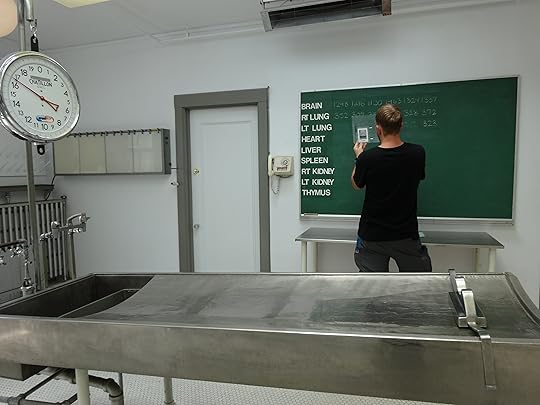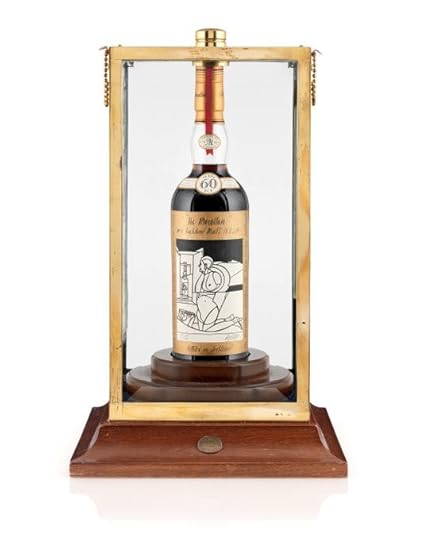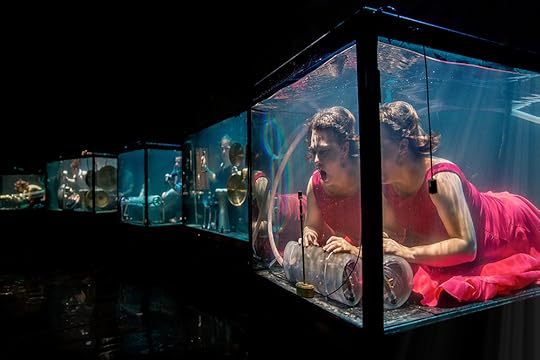Ripley Entertainment Inc.'s Blog, page 314
October 8, 2018
Journeys to Every Country in the World: Part 1 – Cassie De Pecol
Featured in Ripley's Believe It or Not!

INFORMATION
In a blog series, Ripleys.com spoke with travelers who have visited every country. Here’s what one traveler, Cassie De Pecol, experienced.
Cassie De Pecol
Upon arriving in war-torn Somalia in 2016, Cassie De Pecol—an American woman on a quest to visit all of the world’s countries—needed to get from the airport to her hotel. While walking would have taken her just four minutes, the hotel managers instructed her against it, telling her it was too dangerous. Instead, they arranged for her to take an armored vehicle.
“In front of it was a pickup truck, filled with men with machine guns, and in the back of it was another pickup truck, filled with men with machine guns. … That was the only experience I’ve had where I had to go in an armored vehicle, and it was very intense,” De Pecol says.
Along the way, De Pecol, at the time in her mid-20s, could see holes and marks on the sides of the roads from recent explosions.
This was one of many believe-it-or-not moments that De Pecol experienced during what she refers to as Expedition 196—her journey to each and every one of the 193 countries that are member states of the United Nations, plus Taiwan, Kosovo, and Palestine.
Now 29 years old and living in Los Angeles, she dropped out of college in 2011 to travel and encourage sustainability worldwide. De Pecol, who had also once appeared on the Discovery Channel show “Naked and Afraid,” describes herself as somebody who remains committed to anything she puts her mind to. She officially launched her expedition in July 2015. Eighteen months and 26 days later, she broke two world records as the fastest person and fastest female to visit every sovereign nation, staying in each for two to five days on average.
Relying on scheduled public transportation including air travel, buses, ferries, and the like, De Pecol had to adhere to strict rules to earn these titles. She could take taxis but not more than 30 miles within a country, for example. Along the way, she documented her journey on platforms including YouTube and Instagram. Though De Pecol encountered obstacles, those experiences and the people she met taught her valuable lessons about herself and humanity. This is her story.
Launching the Expedition
De Pecol became an ambassador for the International Institute for Peace Through Tourism and attained financial backing from sponsors and investors ranging from CLIF Bar to AIG to Eagle Creek. She also had some money saved up from babysitting and ultimately spent a total of around $110,000 on the expedition.
She ran out of money just six months in. That’s when she realized she would need to work harder to secure sponsorships if she wanted to keep going.
“I was working about 15 hours a day every single day on the expedition, reaching out to sponsors or companies for potential sponsorship, going to networking events, trying to get everything—from cash, goods, and services—to help me finish the expedition,” she says.
Throughout her journey, De Pecol carried a backpack that fit into an overhead bin on a plane. Inside were clothes, toiletries, a laptop, external hard drives, a pillow and a camera with a tripod, memory cards, microphone, and lighting equipment. In most countries, she dressed in all black in part because she knew she wouldn’t be cleaning her clothes often, and dirt wouldn’t be as visible on darker clothing. De Pecol did have to dress certain ways in some places. She wore a hijab, a type of head covering, in Afghanistan, Iran, and Iraq, among a few others.
View this post on Instagram
A post shared by Cassie De Pecol (@cassiedepecol) on Feb 24, 2016 at 3:09am PST
Ironically, De Pecol had a fear of flying—especially over water—when she started her adventure. She had originally planned to first visit New Zealand and then travel by plane to the surrounding Pacific countries to get that part of the trip over with. But a scheduling mix-up and two-week delay caused her to change her plans, and she started with Palau, a sovereign nation in the middle of the Pacific Ocean. In early 2017, her trip ended in Yemen.
Moments of Fear and Tension
Among her most frightening moments was in Grenada, the first country she was detained in, she says. Carrying a plastic bag with vitamins, De Pecol says she was placed in a small, square room with orange walls and broken black chairs. The guards—two men—closed the door. De Pecol asked that a female be present, and they fulfilled the request. Each vitamin pill was tested for traces of cocaine. De Pecol felt as though her negative thoughts had become reality, but she stayed calm. Two hours later, she was free to go.
Having traveled to a number of different countries before her record-breaking expedition, De Pecol says she felt nearly invincible when she began her trip; after all, nothing bad had ever happened to her before. Getting detained in Grenada changed her perspective. “It was a wake-up call, and then any other time I was detained after that, it was like, OK, it’s OK,” she says, referring to experiences she had in countries such as the United Arab Emirates and Libya.
Compassion Around the World
There were also moments when De Pecol was surprised at the goodness of humanity that she witnessed. One example was in Pakistan, which is “not looked at as a place that you go to feel safe or have a nice vacation,” she says. Yet it turned out to be absolutely beautiful. She was just as taken aback by the kind-hearted nature of the people she met there—a dramatic contrast from how Pakistan, a country with a history involving terrorism, is commonly perceived.
For De Pecol, one small planning miscalculation could have implications on her safety and time to complete the journey. In Cuba, she arrived at around 11 p.m. on a Saturday night and took a taxi to her hotel. Halfway there, she realized she had no cash—and her U.S. credit or debit cards wouldn’t be accepted. She thought the hotel could perhaps charge her a different way. But that wasn’t the case, and she couldn’t stay there for the night.
On the side of the road, De Pecol waited with her taxi driver, who spoke only in Spanish. He had refused to let her go off on her own. She understood some of what the driver said when he mentioned that he had three daughters; he would hate for one of them to be in her situation. He invited her to stay with his family for the night, and then he could drive her to the airport the following morning.
They arrived at a “very impoverished kind of household,” De Pecol says. It was small and made of concrete, with a 1950s type of TV inside. Drapes hanging over open windows moved as the wind blew in. The driver’s wife readied a bed for Cassie, and De Pecol went to sleep. The next morning, De Pecol awoke to see the wife sleeping on a one-inch-thick foam pad on the kitchen floor with a sheet covering her. “I realized at that point she had given me her own bed to sleep in,” De Pecol says.
She adds, “I realized how kind humanity is around the world, and how much they just want to help one another out. It was just a heart-warming experience.”
View this post on Instagram
A post shared by Cassie De Pecol (@cassiedepecol) on Oct 22, 2016 at 4:31am PDT
Visiting North Korea
De Pecol often gets asked questions about North Korea, she says—a country where a three-day visa cost her $1,000. She entered from Shenyang, China, as the only Westerner among a group of Chinese tourists. De Pecol says she felt like she was walking on eggshells the entire time; she stayed in the same hotel as Otto Warmbier, the University of Virginia student who was sentenced to 15 years of hard labor in North Korea in 2016. (Warmbier died soon after his return to the United States in 2017, when he was in a coma).
Seemingly minor situations made her nervous, like one instance where she left her coffee cup in the hotel’s breakfast room instead of bringing it back to the café she got it from, which wasn’t permitted.
While De Pecol remembers the monuments of Pyongyang, what really sticks out in her mind is the contrast between the main square of the city—“you could lick the floors it was so clean,” she says—and the impoverished communities she and the other visitors drove through. She saw adults and children washing themselves in rivers alongside dirt roads and small, run-down houses made of concrete.
Facing Criticism
De Pecol dealt with criticism on social media, with some saying her decision to travel by flight wasn’t environmentally friendly, which went against her mission. Others described her as privileged, she says. Critics also pointed out that she didn’t spend very much time in every country.
“All of this stuff really piled on me, and it was throughout the trip when I was completely alone, and I needed to manage it on my own, and I had no one to talk to about it,” she says. But she became a better person because of these experiences. She believes travel should be open-minded and educational and tries not to judge others on how they carry out their adventures.
Crossing the Finish Line
Her trip ended in Yemen, which for her was the most difficult country to get to. Many travelers take a private charter flight there from Socotra Island, De Pecol says. But the break an official world record, De Pecol wasn’t permitted to do so. She ultimately entered by public bus. Traveling for Expedition 196 was complete.
View this post on Instagram
A post shared by Cassie De Pecol (@cassiedepecol) on Feb 3, 2017 at 12:26pm PST
De Pecol wrote a book, which was released this summer, and is working on a documentary. She also started a nonprofit organization that funds female-driven projects that address at least one of the United Nations’ sustainable development goals. De Pecol has also since traveled to Antarctica, and in a few years will add another excursion to the list—to outer space, in a trip sponsored by Virgin Galactic that required an application.
Even as she plans to travel beyond Earth, the lessons she learned from her expedition to every country in the world will stay with her for life. “I remember standing at the back of an airplane and we were going through turbulence, and I just saw everyone’s heads bobbing in the same direction,” De Pecol says. “…And I was like, you know what? It’s like we’re all the same. Everyone around the world just wants a roof over their heads and a hot plate in front of them, and someone around them who really cares about them and loves them.”
She added, “I think if we can start to understand that more, look past the way people are perceived from the outside and kind of look at the manner of all humankind, then we can create a better world and be more open-minded to places and people and cultures around the world.”
By Jordan Friedman, contributor for Ripleys.com
Source: Journeys to Every Country in the World: Part 1 – Cassie De Pecol
The Vancouver Police Museum Has Its Own Morgue
Featured in Ripley's Believe It or Not!

They call it an arresting experience.
See—it’s a pun. Because it’s a police museum. And it’s got a ton of crazy stuff there, like thousands of police artifacts, photos, and documents. It’s been entertaining people by showing them the dark side of Vancouver since it opened in 1986, which marked the centennial of the city’s police force.
Welcome to The Vancouver Police Museum.
Located in an 85-year-old building that used to be a functioning morgue, you can now find an exhibit dissecting the town’s most famous murders (see what we did there? Dissecting?) or another exhibit depicting the ways in which a person can die (the props include a real human brain with a bullet hole in it).
The nonprofit runs on about $200,000 a year and attracts more than 15,000 visitors annually. It’s even been used in an episode of The X-Files.
One room contains all the weapons confiscated by the force over the past decades. You’ll see everything from guns to knives, brass knuckles to bats—and, of course, a few stranger objects too. One looked like two bowling balls with spikes coming out of them attached to a chain.
Then there are the skulls from the Babes in the Woods case.
In 1953, the skeletons of two young children (two boys between the ages of 6 and 10) were found in Stanley Park. Also nearby was a shoe, a lunch box, and other items. It was thought the children had been bludgeoned to death seven to nine years earlier with a hatchet that was found in the area.
The case went, as they now say, viral.
And now, on display in the museum, are the skulls, along with more bones and the hatchet that killed them. The case remains unsolved.

Visitors can also wander into a room that perfectly resembles the one where Errol Flynn (who portrayed Robin Hood on the big screen in 1938) had his autopsy in 1959. After traveling to Vancouver to sell his yacht, Flynn was found dead in a penthouse in the West End.
When it came time for the autopsy, the local pathologist found warts on Flynn’s private area, so he cut them off for examination. That proved to be a problem, as Flynn’s body was also scheduled to have a second examination back in Los Angeles.
It is rumored that the pathologist was told to put the warts back on Flynn, so that’s what he did. He reattached the warts—using tape.

CC Amanda Anderson/Flickr
In another story involving pathologists, there is a perfectly round bullet hole in a nearby glass window.
As the story goes, a pathologist was working one night to determine the death of a body, and he suspected foul play. Just then, a shot came through the window, narrowly missing the pathologist. It was later discovered that the shot came from the man who’d killed the victim. He was trying to kill the pathologist to further cover-up his crime.
Before leaving, everyone should try the sketch artist station, where folks can climb up and try their hand at sketching themselves or someone else. Don’t worry—you’re using a computer, not going freehand.
Remember: if you’re making a visit to The Vancouver Police Museum today, there’s no need to be frightened.
The only time to worry was if you made a visit 85 years ago—back when it was a working morgue and you’d come in on a slab.
By Ryan Clark, contributor for Ripleys.com
CARTOON 10-08-2018
October 7, 2018
CARTOON 10-07-2018
October 6, 2018
CARTOON 10-06-2018
October 5, 2018
Zoo Says Fruit Cultivated For People Is Too Sugary For Animals
Featured in Ripley's Believe It or Not!

[September 30th-October 6th, 2018] An eight-year-old pulls a sword from a lake, a downtown tenement gets wrapped in foil, drunk birds cause chaos, and zoo animals get put on a healthy diet.
8-Year-Old Finds Ancient Sword In Lake
Earlier this summer, eight-year-old Saga Vanecek pulled a sword from Lake Queen in Sweden. She bumped into the object while wading, but the origins of the blade were controversial. Some thought it might be from an ancient knight, while others guessed it was a lost movie prop. Now, Jönköpings County Museum confirms it is really a 1,500-year-old sword from the Iron Age!
Foil-Wrapped House
A historic tenement in Warsaw, Poland, has been covered in aluminum foil. The weathered brick and 1870’s sign now shine a brilliant silver in the sunlight. Artist Piotr Janowski is behind the redecoration and hopes the aluminum-leafing will help people appreciate the beauty of historic architecture.

“Zabkowska 9, Take off!” by artist Piotr Janowski
Drunk Birds Cause Chaos
Gilbert, Minnesota, residents are being warned by police to be wary of those under the influence of alcohol and swerving in the city’s streets. They’re not talking about people, though, but flocks of drunken birds. Young, migrating birds seem to be eating fermented berries, then flying into windows, streets, and stumbling across sidewalks.

Bottle Of Whisky Sells For $1.1 Million
The Macallan Valero Adami 1926 is a whisky without peers. Aged for 60 years, and then packaged in just 12 bottles, the artwork on the label is as rare in the whisky inside, penned by Valerio Adami. One rare bottle sold for $1.1 million at auction, though there’s no word on whether the winner plans to drink it.

Bonhams Auction
Zoo Cuts Fruit For Being Too Sugary
Thinking they were feeding their animals the healthiest diet possible, Melbourne Zoo veterinarians had to take a second look at fruit when the animals continued gaining weight and losing their teeth. They had been feeding their primates and red pandas fruit from local markets, but now think it has been cultivated to contain too much sugar for their animals. Caretakers say that fruit has been cultivated to be so much sweeter for human consumption and that the fruit scavenged in the wild would be much different. Now, the zoo’s red pandas and monkeys have to eat their vegetables.

Source: Zoo Says Fruit Cultivated For People Is Too Sugary For Animals
CARTOON 10-05-2018
October 4, 2018
Aquasonic: The Haunting Sounds Of Underwater Music
Featured in Ripley's Believe It or Not!

Using specially designed instruments, Danish group Aquasonic is the first ensemble to perform music underwater and does so without using breathing apparatuses.

Photo credit: Charlotta de Miranda
Instead of using SCUBA equipment, members must frequently resurface to breathe. The performers and their equipment start submerged in water-filled tanks equipped with hydrophones. Hydrophones are specially-built microphones that are used to pick up the band’s haunting concertos even while underwater.
The microphones aren’t the only specially-made equipment the band uses. They’ve also developed their own subaqueous instruments, including an underwater organ known as a hydraulophone, a crystallophone, a rotacorda, as well as a modified violin.
It took the band years to perfect the technology they use to perform underwater, conducting countless experiments with deep sea-divers. Learning to sing underwater was a whole other challenge. Lead singer Laila Skovmand has to produce vocals that lead the music all while rationing air was particularly difficult.
A hybrid of music, live performance, visual arts, and new technology, the group masters a huge range of aesthetics, skills, and genres. By fluctuating in between all of these artistic disciplines, they’ve created a truly unbelievable experience.

From conga-dancing dogs and bicycling ballerinas, to hair-raising feats of strength and death-defying motorcycle stunts, Ripley’s Believe It or Not! A Century of Strange! is sure to delight readers of all ages. With over 1,200 weird-but-true stories from around the world and 256 pages of wild and wonderful photography, this year’s collection of all things odd is not-to-be-missed.
QUIZ: Which A Century of Strange Personality Are You?
Moved by the sub-aquatic concerto? Find out which friendly (or freaky!) face from Ripley’s Believe It or Not! A Century of Strange you are! Take this quiz to find out!
Don’t miss out on being an ODDthority on everything strange, get your copy on Amazon today!
Can Contact With A Toad Really Cause Warts?
Featured in Ripley's Believe It or Not!

Or Not
In today’s world many misconceptions have been perpetuated—becoming modern day “facts”—when, in reality, myths and hearsay have taken over. Sorry to burst your bubble, but in this weekly column, Ripley’s puts those delusions to the test, turning your world upside down, because you can’t always…Believe It!
Today: Does touching a toad cause warts?
We’ve all heard the saying, sometimes from an overzealous parent and sometimes from a person who simply thinks amphibians are gross: “Don’t touch that toad! It’ll give you warts!” The truth of the matter? It definitely won’t. However, because of their natural and protective accouterment, it’s probably still a good idea to let sleeping toads lie.
Why Do We Think Toads Cause Warts?
No one really knows exactly where this rumor came from, probably because it’s been around for a long time. Baby boomers and millennials alike have pretty much all been told as children they were going to get warts if they tried to handle toads.

Still, it seems like a case of misplaced human logic. Toads have bumps on their backs, the bumps look kind of similar to warts, and warts can be contagious. Therefore, people go around thinking human warts and toad bumps are the same things, and that the latter will cause the former.
Frogs seem to have been put in the same boat, mostly because many people can’t tell the two apart even though they have a number of distinctions between them, such as:
Frogs usually live in water while toads live on land, albeit near water.
Frogs have teeth and toads don’t.
Frogs are longer than toads.
Frogs are smooth while toads are the ones with the wart-like bumps.
Toads Will Not Give You Warts
If you were told toads could give you warts when you were a kid, you can now revel in the fact that this isn’t actually true. There are many different types of warts, around fifty or so, but none of them are caused by toads or frogs. They are instead caused by the human papillomavirus (or HPV), which can result in the multiplication of cells on the outside of your skin, creating a bump. Warts aren’t dangerous, treating them usually isn’t a problem, and in no way are they caused by amphibians.

Toad Bumps Probably Still Aren’t Good For You
However, this isn’t an endorsement to run outside and start picking up hopping creatures. The bumps that distinguish a toad from a frog and made everyone believe these creatures could cause warts are actually often glands. The glands on certain toads can secrete toxins meant to protect the toad and to keep animals in the wild from eating them. These toxins can also burn human skin in some cases.

So, next time you see a bunch of kids handling a toad, you can teach them the facts after reminding them it’s still probably a good idea to put it down.
By Julia Tilford, contributor for Ripleys.com
CARTOON 10-04-2018
Ripley Entertainment Inc.'s Blog
- Ripley Entertainment Inc.'s profile
- 52 followers








